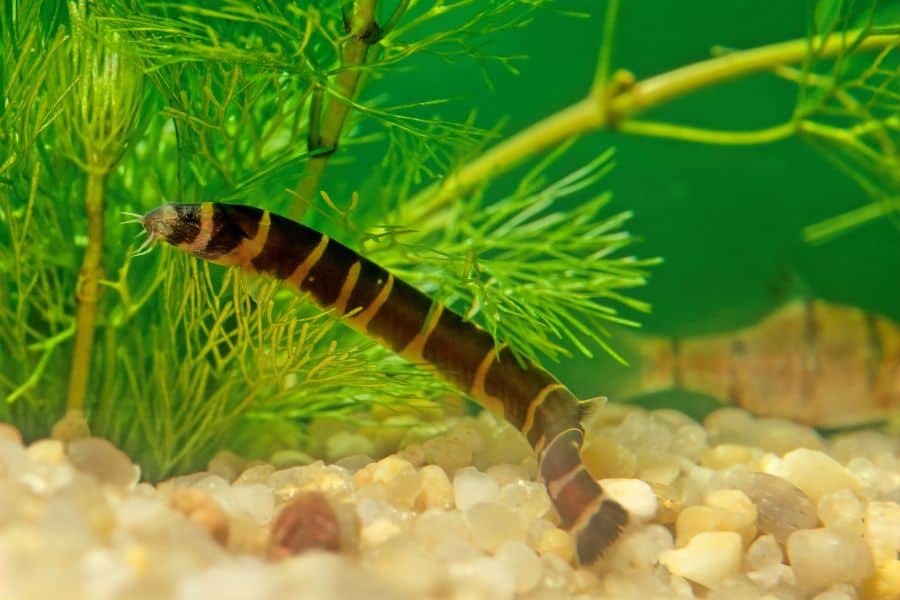You should ideally keep at least five Kuhli Loaches together for a better social experience. Having more of them in your tank will make them happier and more active.
However, if your tank size doesn’t allow for this many fish, keeping two or three Kuhli Loaches together should still work well. They are social creatures and prefer the companionship of their own kind.
Table of Contents
Optimal Number Of Kuhli Loaches For A Tank
To ensure the optimal well-being of your Kuhli Loaches, it is advisable to keep them in pairs or more. Ideally, having five or more together is recommended as it promotes a sense of security and encourages more active behavior. However, if your tank size does not allow for a larger group, having two or three Kuhli Loaches can still create a harmonious environment.
These social creatures thrive in the company of their peers and are more likely to explore their surroundings when they feel comfortable. In terms of tank mates, any non-aggressive fish species can coexist with Kuhli Loaches. By following these guidelines, you can create a thriving and diverse aquatic community in your tank.
Tank Size Considerations For Kuhli Loaches
Ideally, you should keep more than one Kuhli Loach in your tank. It is recommended to have a minimum of five or more together. This will ensure that they are happy and more active. However, if your tank size does not allow for this many fish, you can still keep two or three Kuhli Loaches.
These fish are social creatures and enjoy the company of their own kind. Keeping them in a group will make them feel more comfortable and less afraid to explore their environment. In terms of tank mates, Kuhli Loaches are non-aggressive and can coexist peacefully with other fish species.
Provide a suitable environment with hiding spots and soft substrate to mimic their natural habitat, and they will thrive in your tank.
Best Tank Mates For Kuhli Loaches
To ensure a harmonious community tank setup for your Kuhli Loaches, it is important to choose compatible fish species. While Kuhli Loaches prefer the company of their own kind, it is recommended to have at least five or more together.
This will help them feel more secure and active. However, if your tank size does not allow for a larger group, two or three Kuhli Loaches can still get along well. When selecting tank mates, opt for non-aggressive fish species.
Some suitable options include Cory catfish, Guppies, Neon tetras, Tetras, and Siamese fighting fish. Avoid aggressive or territorial fish that may harm or stress out your Kuhli Loaches. By following these guidelines, you can create a peaceful and enjoyable environment for your Kuhli Loaches and their tank mates.

Credit: www.acaquarium.com
Frequently Asked Questions For How Many Kuhli Loaches Should I Get
Do Kuhli Loaches Need To Be In Pairs?
Kuhli loaches should ideally be kept in groups of five or more to ensure they are happy and active.
Can You Keep 3 Kuhli Loaches Together?
Ideally, it is recommended to keep at least five Kuhli loaches together for a better social experience. However, if your tank size doesn’t allow for that many, two or three will still get along well.
Can You Keep Just One Kuhli Loach?
No, it is not recommended to keep just one kuhli loach. They are social creatures and feel more comfortable in a group of five or more.
How Many Kuhli Loaches In A 5 Gallon?
Ideally, it is recommended to have five or more Kuhli Loaches in a 5-gallon tank for a happier and more active fish.
Q: How Many Kuhli Loaches Should I Get For My Aquarium?
A: Ideally, it is recommended to keep at least five Kuhli Loaches together for the best social experience. They will be less shy and more active in a larger group.
Q: Can I Keep Just One Kuhli Loach?
A: No, it is not recommended to keep just one Kuhli Loach. They are social creatures that love company and feel more comfortable with friends. Keeping them alone may cause them to hide and be afraid to explore the tank.
Q: What Are Some Suitable Tank Mates For Kuhli Loaches?
A: Kuhli Loaches get along well with other non-aggressive fish species. Some suitable tank mates include Cory catfish, loaches, guppies, neon tetras, tetras, and Siamese fighting fish.
Conclusion
To ensure the happiness and activity of your Kuhli Loaches, it is recommended to keep them in a group of five or more. This allows them to feel more secure and social, resulting in a more engaging aquarium experience. However, if your tank size does not permit keeping a larger group, two or three Kuhli Loaches can still coexist harmoniously.
While they are not schooling fish, Kuhli Loaches are social creatures that enjoy the presence of their companions. Keeping them alone may cause them to become fearful and hide, inhibiting their natural behavior. Additionally, Kuhli Loaches are compatible with non-aggressive species, so you have plenty of options for tank mates.
Ultimately, the goal is to create an environment that promotes the well-being and happiness of your Kuhli Loaches.
I am a passionate aquarist with over 30 years of hands-on experience in fishkeeping. My journey began at a young age, collecting fish from the wild and learning through experimentation. Specializing in tropical fish, I bring a deep understanding of the hobby to FishKeepingMadeSimple. The site provides honest, detailed reviews of essential products and accessories to help fellow enthusiasts create the best environments for their fish.










[…] If you notice any symptoms of these diseases or anything else that seems out of the ordinary, it’s important to act quickly to prevent them from spreading to other fish. Quarantine affected fish immediately and seek treatment advice from a veterinarian or aquarium expert […]
[…] diet or no feeding at all, depending on the water temperature. Consult with your local aquatic experts or koi breeders for advice on winter feeding […]
[…] needs of other fish species as well. If you have bottom-dwelling fish, such as Corydoras catfish or Kuhli loaches, a sandy substrate would be ideal. It mimics their natural habitat and helps prevent injury to […]
[…] your fish’s safety first is a must, and get an expert’s advice when […]